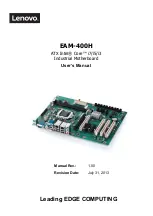
ETX-CN700
Appendix 1
Page | 33
Connector X2
ISA Signals
All required signal pull-ups are integrated into the ETX CN700 module. In some applications it may be
desirable to add additional signal termination components to the baseboard.
SD[0..15]
These signals provide data bus bits 0 to 15 for any peripheral devices. All 8-bit devices use SD0[0..7] for data
transfers. 16-bit devices use SD[0..15]. To support 8-bit devices, the data on SD[8..15] is gated to SD[0..7]
during 8-bit transfers to these devices. 16-bit CPU cycles will be automatically converted into two 8-bit cycles
for 8-bit peripherals.
SA[0..19]
Address bits 0 through 15 are used to address I/O devices. Address bits 0 through 19 are used to address
memory within the system. These 20 address lines, in addition to LA[17..23] allow access of up to 16MB of
memory. SA[0..19] are gated on the ISA-bus when BALE is high and latched on to the falling edge of BALE.
SBHE#
Bus High Enable indicates a data transfer on the upper byte of the data bus SD[8..15]. 16-bit I/O devices use
SBHE# to enable data bus buffers on SD[8..15].
BALE
BALE is an active-high pulse generated at the beginning of any bus cycle initiated by a CPU module. It
indicates when the SA[0..19], LA17.23, AEN, and SBHE# signals are valid.
AEN
AEN is an active-high output that indicates a DMA transfer cycle. Only resources with a active DACK# signal
should respond to the command lines when AEN is high.
MEMR#
MEMR# instructs memory devices to drive data onto the data bus. MEMR# is active for all memory read
cycles.
SMEMR#
SMEMR# instructs memory devices to drive data onto the data bus. SMEMR# is active for memory read cycles
to addresses below 1MB.
MEMW#
MEMW# instructs memory devices to store the data present on the data bus. MEMW# is active for all memory
write cycles.
SMEMW#
SMEMW# instructs memory devices to store the data present on the data bus. SMEMW# is active for all
memory write cycles to address below 1MB.
IOR#
I/O read instructs an I/O device to drive its data onto the data bus. It may be driven by the CPU or by the DMA
controller. IOR# is inactive (high) during refresh cycles.
IOW#
I/O write instructs an I/O device to store the data present on the data bus. It may be driven by the CPU or by the
DMA controller. IOW# is inactive (high) during refresh cycles.
IOCHK#
IOCHK# is an active-low input signal that indicates that an error has occurred on the module bus. If I/O
checking is enabled on the CPU module, an IOCHK# assertion by a peripheral device sends a NMI to the
processor.
IOCHRDY
The I/O Channel Ready is pulled low in order to extend the read or write cycles of any bus access when
required. The CPU, DMA controllers or refresh controller can initiate the cycle. Any peripheral that cannot
present read data or strobe in write data within this amount of time use IOCHRDY to extend these cycles. This
signal should not be held low for more than 2.5 μs for normal operation. Any extension to more than 2.5 μs does
not guarantee proper DRAM memory content due to the fact that memory refresh is disabled while IOCHRDY
is low.
MEMCS16#
The MEMCS16# signal determines when a 16-bit to 8-bit conversion is needed for memory bus cycles. A
conversion is done any time the CPU module requests a 16-bit memory cycle while the MEMCS16# line is
high. If MEMCS16# is high, 16-bit CPU cycles are automatically converted on the bus into two 8-bit cycles. If
MEMCS16# is low, an access to peripherals is performed 16 bits wide.













































